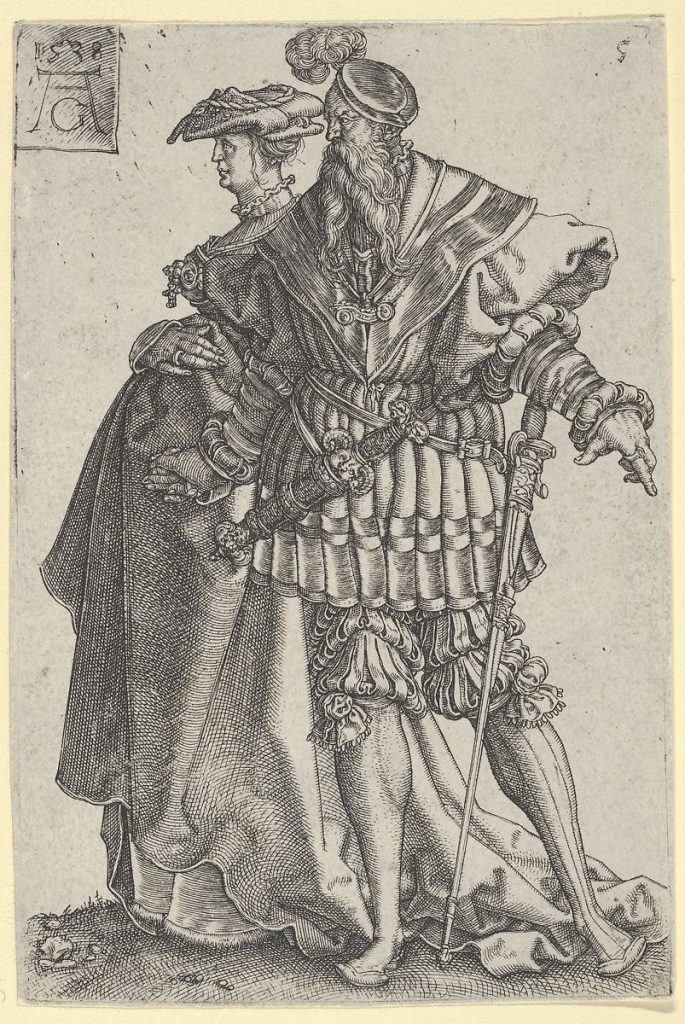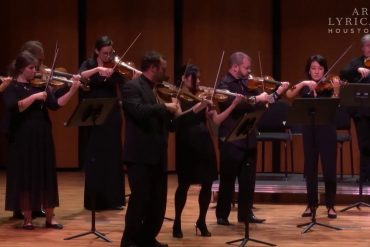To truly understand historical fencing, it’s essential to grasp the historical context in which it developed. While we often lack detailed information about the fencing masters who wrote our treatises, we do have considerable knowledge about the world they lived in—yet we frequently overlook it.
Such is the case with the Habsburg family and their major influence on the martial arts we now call Kunst des Fechtens.
Friedrich III and the Marxbrüder
It is well documented that the oldest known fencing manuscript is the I.33, most likely written at the end of the 14th century. This was followed by early works, such as Codex Wallerstein and the so-called Dobringer manuscript in the first half of the 15th century. But why did we suddenly see an explosion of fighting treatises in the latter half of the 15th century and throughout the 16th, particularly across the Holy Roman Empire?
A key factor to consider is the privilege given exclusively to the Marxbrüder by the Habsburg Emperor Friedrich III, in 1487, to teach fencing across the Empire, to certify masters, and to grant the title of Maister des Langes Schwerts. This title would gain relevance during Maximilian I reign, since, arguably, it was required to obtain the Doppelsoldner rank for those seeking to acquire a double payment within the ranks of the Empire.
Maximilian and the Landsknechts
Although, his importance for many arts is well documented, Maximilian’s importance for the development of the Kunst des Fechtens is often overlooked. Unlike his father, Maximilian did get involved in several armed conflicts and transformed the Holy Roman Empire’s warfare tactics by creating the Landsknecht units across the Empire, being often referred to as the “father of the Landsknecht”.
His role in the creation and institutionalisation of the Landsknecht was both strategic and organisational, deeply tied to his vision of a reformed, centralised imperial military. He structured these troops based on Swiss mercenaries but brought them under imperial control. This allowed for a loyal and cost-effective alternative to feudal levies and unreliable noble cavalry, especially as warfare evolved with pike formations and gunpowder.
To formalise the role of the Landsknechts, he issued military ordinances (known as Artikelsbriefe), which codified pay structure, discipline and justice system (under Feldgericht, or field court), and unit organisation. Maximilian is said to have supported and perhaps even encouraged the flamboyant style associated with the Landsknecht—slashed clothing, bright colours, and personal flair—as a visual symbol of imperial identity and esprit de corps. What created a unique military culture, semi-autonomous and proud, but tied to the emperor through loyalty and pay.
Maximilian was not only a patron, he was actively involved in military reforms, and as, probably the last, warrior-emperor. He personally campaigned, wrote about chivalric ideals, and envisioned a “Reichsheer”—an imperial army that would serve the entire Holy Roman Empire. This vision laid the foundation for the Landsknecht as the Empire’s backbone in the early 16th century.
Maximilian and the manuscripts
It has also been speculated that the emperor might have been involved in the creation of two fencing treatises, the “Weapon Training, or Albrecht Dürer’s Meditation on the Handling of Weapons”, or MS 26-232 by Albrecht Dürer and the so-called Goliath Manuscript (MS germ. quart. 2020).
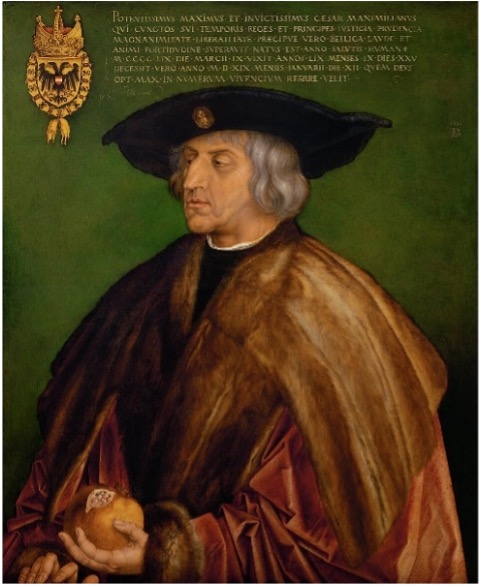
There is no conclusive evidence that these works were commissioned by the Emperor, or that the artist created them to get his favour, but linking Dürer’s work to Maximilian is tempting since the German painter worked for the Emperor from 1511 and until his death in 1519. Starting in 1512, Emperor Maximilian I also became Albrecht Dürer’s most significant patron, commissioning large-scale works like The Triumphal Arch and The Triumphal Procession, he also contributed to the Emperor’s printed prayer book and painted several portraits of him.
Maximilian’s devotion for the painter was such that a story exists where the Emperor holds a ladder for Dürer, after a nobleman refused to do it, stating that
“he could make a noble out of a peasant any day, but he could not make an artist like Dürer out of a noble”.
This story was later depicted in an 1849 painting by August Siegert and was referenced in the 2022 Dürer exhibition in Nuremberg. Additionally, during restoration works in 2020, a new hypothesis has been presented that posits that the German painter could have participated in creating the murals at St. Stephen’s Cathedral. This theory is based on a piece of handwriting, possibly connecting him with Maximilian earlier than officially recorded.
Connecting the Goliath Manuscript to Maximilian is more speculative. However, the commission of the work remains unclaimed, and the cost of creating such a detailed work would have been high. According to Zabinski, the main reasons to argue such a hypothesis are that Maximilian was a lover of martial arts and commissioned several related works, and that there was a strong presence of experienced fighters in Maximilian’s court. He highlights the master at arms, Hans Hollywars, who “developed the art of combat, according to the Emperor’s will, according to the Zettel”. Zabinski also argues that there are some similarities between Goliath’s and Wallerstein’s dagger sections, which also inspired Dürer’s works, that may have also been commissioned by the Emperor. Additionally, the lavishness of the manuscript indicates that it was commissioned by a wealthy man; also, the fact that it was left unconcluded could be related to the Emperor’s death in 1519. The depiction of Hungarian Hussars in the manuscript is consistent with other works commissioned by the emperor. And lastly, there are also stylistic similarities between the Thauerdank (1517) and the Goliath Manuscript.
Der Freydal
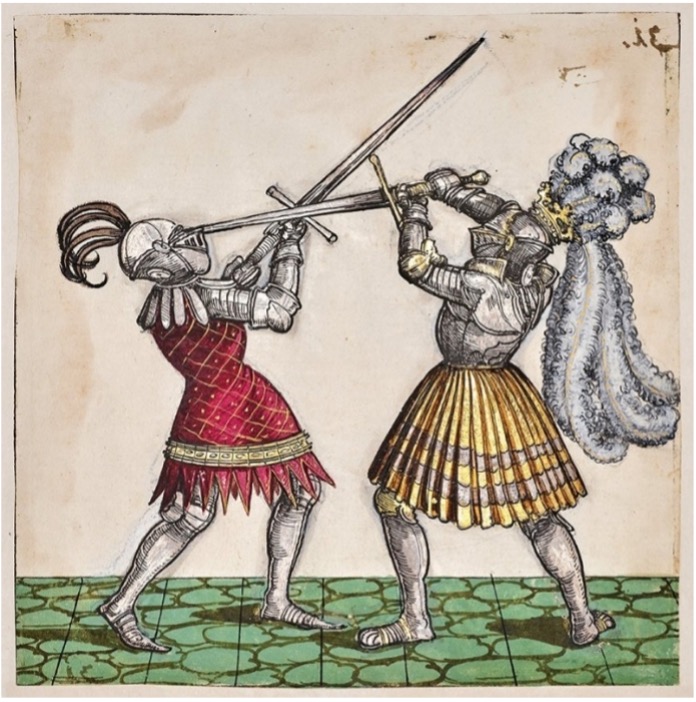
Probably the most important contributions of Maximilian I to the Kunst des Fechtens remain unexplored by most historians and fencing enthusiasts. Considered by many the last Knightly Emperor (claim only contested by Henry VIII in England) Maximilian not only organized and took part in several tournaments, and adapted legends of old to embellish his image as a warrior (see Der Teuerdank) in the empire’s imagination but commissioned one of the richest Türnierbuch (tournament book) in history, Der Freydal.
Der Freydal contains over 200 richly detailed illustrations, some decorated with gold, portraying imagined tournaments and noblemen. Its primary aim appears to have been the glorification of the Emperor. The book offers insights into tournament culture, armour styles, and courtly rituals—and it includes detailed depictions of fencing techniques consistent with contemporary fechtbücher.
Its content is so vast that it deserves an in-depth analysis of its own that I will have to leave for a later paper, but it perfectly exemplifies the Emperor’s passion for the knightly arts and his unquestionable involvement and role in the development of the martial culture of the late 1400s and early 1500s in the Germanic area.
Rudolf II and the Federfechter
A central figure for the revival of Prague was Frederick III’s great-great-great-grandson Rudolph II. In 1576, he breathed new life into Prague by relocating the imperial court to the city. Despite being considered an ineffectual ruler, Rudolf II’s patronage of the arts left a lasting impact. He sponsored numerous artists and curated an artistic collection that was highly esteemed during his time, contributing to the development of an artistic style often referred to as Rudolfine Mannerism.
And in 1607, Emperor Rudolf II officially recognised the Freifechter von der Feder, also known as the Federfechter, by granting them the authority to certify fencing masters within the Holy Roman Empire. A privilege previously only extended to the Marx Brüder, who were recognised in 1487.
Jud Ott Wrestler to the Lords of Austria
In his work of 1470, Cgm 1507, master Paulus Kal mentions that master Jud Ott used to work for the princes of Austria,
Master Ott, a Jew, who was the wrestler to the Lords of Austria.
Although Ott’s precise lifetime is uncertain, it is speculated that he might have died before 1470’s mention in Paulus Kal’s work, if he lived in the early 1400s he might have taught either Albert II, the Magnanimus (1404 – 1439), Duke Ladislaus V (1440 – 1457) or none the less Archduke Friedrich III (1457 – 1493). It is important to remember that from 1395 until the reign of Friedrich III, the Duchy was split between Albrecht III sons and his respective lines.
Beyond who might have been Ott’s patron, the importance of his work for the Liechtenauer and the German Martial Arts Tradition is beyond question, being probably the most copied gloss on grappling across the early German treatises.
Paulus Kal master of Sigismund von Tyrol
Finally, master Paulus Kal himself is known to have worked for Archduke Sigismund of Austria Tyrol for a brief period after his previous patron, Ludwig XI, the rich, died in 1479. He likely died before his patron in 1496, but there is no further evidence of his life after some interrogations related to the witch trials that were conducted by Heinrich Kramer on 17 October 1485 in Innsbruck.
The Imperial Armoury
A remarkable note for us historical combat enthusiasts is that Archduke Sigismund’s gothic armour is currently kept at the Royal Armoury in Wien in pristine condition and can be seen exhibited next to Maximilian’s I collection of arms and armour, other pieces that belonged to Emperor Maximilian II, and many other noble men and knights from the Habsburg empire.
Another important piece of armour displayed at the Imperial Armoury is the Landsknecht costume armour of Wilhelm von Rogendorf, who served the Habsburgs as Hofmeister and later Obersthofmeister, until he died in 1541, during the Austrian Siege of Buda. This armour is the central piece of Stefan Krause’s book Fashion in Steel, in which the author delves back five centuries to the political, social, and cultural context in which von Rogendorf lived.
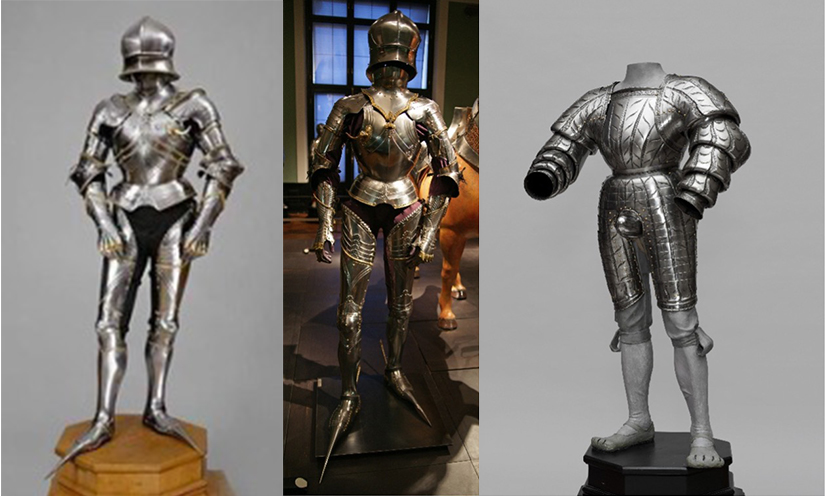
Conclusion
Although it is possible to study and practice the Kunst des Fechtens tradition without knowing the context under which it was built and developed, the more we know and the more we understand and appreciate its context, the better we can understand the art we are passionate about, and even perhaps pay the due respect it is owed to the people who laid the foundations, willingly or unconsciously, for or art to develop, in this case, the Habsburg family and the Holy Roman Empire.



